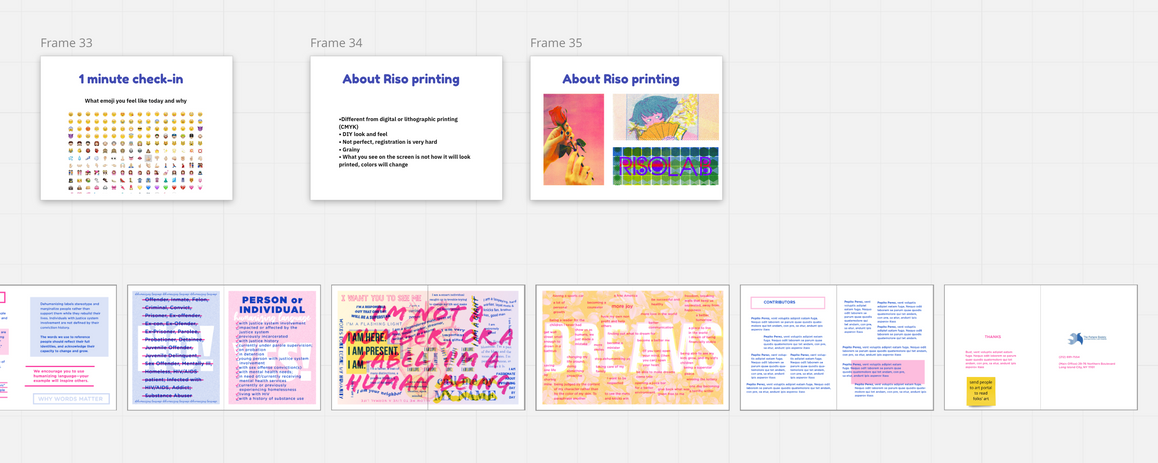
We Are More Than A Label
A zine that invites to use humanizing - person-first - language when talking about community members who have been affected by the criminal legal system.
Client: The Fortune Society
Year: 2021
Team: Creative Arts Program members at The Fortune Society
My Roles: Facilitator, Community Designer, Graphic Designer
Background
I became part of the Arts community at The Fortune Society when we worked on Art Portal. By doing that project I learned a lot about the community members’ wishes and pain points.
I learned about the community members’ aspiration to “change people’s minds”, and “Change the perception from you are “just a felon to you’re valuable”".
The Director of the Arts program, who is also a writer, is very aware of the impact that language has in shaping, creating, or limiting our perceptions, imaginations, and lives.
With all her knowledge of the community and the insights that we learned together while building Art Portal, she came to me with the idea to create a resource with the community to raise awareness about the language we use when talking about community members who have been impacted by the criminal legal system.
How Might We create an accessible resource that raises awareness about the impact of word choice/use, and adds to the efforts to humanize community members with justice histories and reduce social stigma?
Tools & Methods
Process
In my public presentation of Art Portal, I talked about my use of humanizing language when referring to the people I co-created the project with. I explained how words like “felon”, “criminal”, “inmate” among others are words that cause damage and help deepen the social stigma for folks who have been impacted by the criminal legal system.
Later in the presentation, I shared quotes from community members that expressed their desire to be treated with dignity, to “show people we are more similar than different”, to live without the social stigma.
To close, I shared that the long-term vision for Art Portal as a platform was for it to be a means to raise awareness of the impacts of Mass Incarceration and the Carceral State, and to change how we, as a society, treat those who have been impacted by those systems.
After this, the Director of the Creative Arts program approached me with the idea to create another medium to add to the vision of changing society. This time, a tool that specifically addressed language and word choice.
Given my experience in book/print/editorial design, plus the fact that I’m into risograph printing, we had the idea for the tool to be a riso-printed zine. We pitched the zine idea to the community and they liked it. And they also had a lot of questions and ideas for it.
I designed and facilitated a co-design workshop with the group in which, among other things, we agreed on the values that grounded our work and group dynamics, they expressed their goals and visions for the publication, and talked about their identities and aspirations, their humanity.
I took all the information from the workshop and started to translate concepts and complex ideas into images and visual elements that could be printed. I made decisions such as keeping people's words intact and not interpreting them, and following some of their suggestions for aesthetics and visual language. All while accounting for the specific constraints that come with risograph printing.
I facilitated a second workshop where I showed the community the art direction I had created along with sketches and mockups, and opened the space for their feedback.
From then on, it was a back-and-forth of edits and refinement until we got to a final product we all were happy with.
Outputs & Outcomes
After many iterations, the approved design was sent out to print at Lucky Risograph, a local, small, POC-owned risograph printing studio. 750 zines came out fresh from the printer just in time to make it into We Choose to Bloom, an exhibition the Creative Arts Program had at MoMA PS1’s "Homeroom". They were given out for free, as a souvenir (an undercover educational agent) of the exhibition.
The community members who co-created the zine with me reported feeling proud and happy about the process and the final product.
A second run of 750 was printed a few months later. To date (spring 2022), the zine has been distributed at Fortune, MoMA PS1, Socrates Sculpture Park and Second Stage Theater as well as shared with sister agencies, arts organizations, legislators, funders and other stakeholders. Through the partnership with Second Stage, copies were also mailed to high school students with nonprofit Exploring the Arts and the School for Social Justice in Long Branch, NJ.
The files for electronic use and distribution as well as ready-to-print files are available here.
* Photos by Vinny DiVito
































